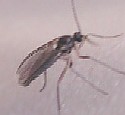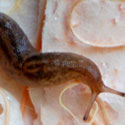Compost Heap
Biodiversity in my small backyard reaches its peak in the compost heap. The reason is simple: there is an abundance of ready food resources. True, the biomass of either the Blue Palo Verde tree or the Western Soapberry far exceeds that of the heap, but the trees' biomass is protected by virtue of being alive and defended. The dead leaves, twigs, and vegetable scraps from my kitchen on the other hand are available for immediate recycling.
Like any ecosystem, the compost heap is a dynamic system where primary resources (The producers, living plants, are themselves physically outside of the system.) are competed for by primary consumers, which are in turn the food source for grazers, which then are used as food by predators every bit as ferocious as those on the Serengeti. Even the predators themselves have predators. With so much life, there is abundant death. Organism die and those that thrive continue to produce yet more waste (feces) to be recycled further. Energy contained in the starting material is expended and vital nutrients such as nitrogen and phosphorous are cycled from organism to organism. The net result of all this activity is the conversion of dead plant material into a rich humus.
My heap system is a simple one: leaves, pruning waste, cucumber peels, radish tops, etc. are placed on the top of the heap. A white board is used as a cover to keep some of the direct sunlight off and to help hold in some of the moisture. As the various molds, insects, earthworms (Eisenia foetida) and bacteria degrade my offerings, the volume decreases so that my heap maintains a constant height even as new material is added almost daily. The balance of materials added helps to keep down odors, breeding of house flies, and the attraction of larger scavengers (i.e. I don't want cockroaches, rats or dogs!). High energy food waste such as meat scraps, potato peels and whole fruits is not entered. Because a lot of the compost is largely cellulose (dead leaves and twigs) it is necessary to add some green wastes that have nitrogen and phosphorous. These nutrients improve the efficiency of molds and bacteria in breaking down the cellulose; without them the heap would tend to grow rather than stay constant. There is a desirable balance between nutrients, energy and cellulose.
Inhabitants of the Compost
The insects, mites, spiders, crustaceans, centipedes, fungi, actinomycetes and bacteria common in the compost heap are also commonly encountered in naturally occurring compost such as leaf piles or beneath rich soil. They are simply more abundant in my augmented system.
- Ants
- --Of the ants described above only Monomorium and Brachymyrmex are not commonly encountered in the compost heap.
- Dark-winged Fungus Gnat (Sciaridae: Sciara sp.)
- --Long slender legs and long antennae give this gnat a delicate appearance. These same gnats often live in the soil of potted house plants and in mushroom gardens. As in the compost heap, their principal food are the fungi. The leggless larvae of this and the next species tunnel through the masses of moldy material to feed.
- Minute Black Scavenger Fly (Scatopsidae: Scatopse sp.)
- --Noticeably black and rather thick bodied gnat about 3 mm long with short antennae and legs. Pairs are often seen coupled together tail to tail, the female dragging the male about. These small flies specialize in feeding on decayed plant material.
- Heleomyzid Fly (Heleomyzidae)
- --A very small fly only 1.7 mm long. It is dark brown and seems to become more abundant soon after fresh vegetable matter is added to the compost heep.
- Centipede (Henicops sp.)
- --A slender reddish brown centipede with adult size 12 mm. Centipedes have many pairs of legs, this one 15 pairs, with one pair at each body segment. The chewing mouthparts are small, but are greatly aided by the first pair of heavy pincerlike legs that are also equipped with poison glands. Hunting beneath rocks and soil these predators are mostly blind with just a pair of ocelli (simple eyes). They are harmless to humans. The Garden Centipede (Lithobius) is similar to this one; there are several common species in North America likely to be found in compost heaps.
- Gray Garden Slug (Deroceras reticulatum)
- --Slugs are simply snails without shells. Gray Garden Slugs commonly move into moist gardens in the Sonoran Desert having been brought to this region by pioneering farmers aand homesteaders. They were not brought intentionally; instead they were stow-aways in potted plants that were later planted in orchards etc. Gray slugs usually feed on dead leaves and fallen flowers, but when that food is not available they may begin feeding on green plants and be recognized as pests.
- Sowbug (Porcellio laevis)
- --Crabs, lobsters and barnicles are classified as crustaceans so it might be surprising to find another member of this mostly aquatic class inhabiting a terrestrial compost heap. Sow bugs are indeed crustaceans with two pairs of antennae, seven pairs of legs, and chewing mouthparts. The eggs are laid into a brood pouch on the underside of the female's posterior. Once hatched the young remain in the pouch for one to two months more before they can emerge and live on their own. These young are similar to the adults; there is no metamorphosis as in most insects and so both feed similarly on leaf mould.



